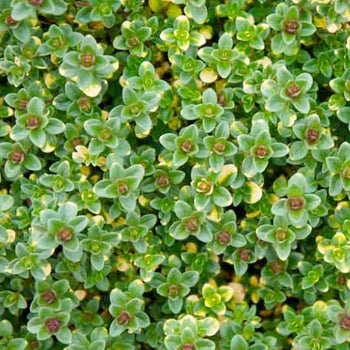
Season: All Year
Looking for a Specific Herb?
Search Our Herb Almanac Below:
|
|
|
Green throughout most of summer and fall, Doone Valley Thyme enters its variegated stage in the cool of Spring. Heavily scented of lemon, Doone Valley Thyme makes a nice little mat or mound for filling in and around taller plants like Grape Sage or Lemon Verbena. Each plant spreads to about 18 inches and produces 3 or 4 inch long flower heads full of pink flowers. If a flatter ground cover is desired, these flowers should be sheared off after bloom. If they are left, the thyme will crawl over the spent flowers, adding height to the mound.
Doone Valley Thyme lists as hardy to Zone 6, but there have been some reported successes in Zone 5. It is helpful to mulch around ground cover thymes to fend off encroaching weeds until the plants can fully shade the ground from any light that might germinate weed seeds. When mulching, do not cover the plants; rather surround them with mulch and filter the mulch down into the thyme with your fingers.
Doone Valley Thyme is not a cooking thyme. The Lemon scent does not hold up in cooking like regular Lemon Thyme does. However, both the leaves and the blossoms can be used as brilliantly colored, fragrant garnish. Or, you can leave the flowers for the bees. Bees love all blooming thymes.
|
 |

Mature Height
36 Inches |
 |

Mature Width
24 Inches |
 |

Light
Sun |
 |

Water
Moderate |
 |
|
Uses
Thyme is sold both fresh and dried. While summer-seasonal, fresh greenhouse thyme is often available year-round. The fresh form is more flavorful, but also less convenient; storage life is rarely more than a week. However, the fresh form can last many months if carefully frozen.
Fresh thyme is commonly sold in bunches of sprigs. A sprig is a single stem snipped from the plant. It is composed of a woody stem with paired leaf or flower clusters ("leaves") spaced 15 to 25 millimetres (1⁄2 to 1 inch) apart. A recipe may measure thyme by the bunch (or fraction thereof), or by the sprig, or by the tablespoon or teaspoon. Dried thyme is widely used in Armenia in tisanes (called urc).
Depending on how it is used in a dish, the whole sprig may be used (e.g., in a bouquet garni), or the leaves removed and the stems discarded. Usually, when a recipe specifies "bunch" or "sprig", it means the whole form; when it specifies spoons, it means the leaves. It is perfectly acceptable to substitute dried for whole thyme.
|
|





















